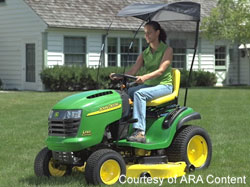 (ARA) - Whether there's midseason drought or a family vacation, keep your lawn green and healthy this summer with advice from John Deere's "Mow Master" Bill Klutho.
Q: When my town enforced water restrictions during last year's drought, my lawn suffered. Besides moving to a rainforest, what can I do?
-- Wishing for Water
A: Dehydration can be a common problem, even if there isn't a drought. Signs such as curling grass blades, a bluish-green color and footprinting (when you can see your footprints in the grass) mean your grass is thirsty. Most lawns need about an inch of water per week, wetting the soil about six inches deep. To measure watering time, put a mark one inch from the bottom of several plastic containers and spread them around the lawn. Clock the time it takes to reach the one-inch mark and water for that length of time in the future. And water in the morning so your lawn isn't left wet overnight.
When dealing with drought, John Deere recommends following any water restrictions in your area and considering these tips:
* During short droughts, if the grass is still growing, mow on the high side and water infrequently, but deeply, to encourage a strong, deep root system. Watering just a little bit invites weeds to grow.
* Water thoroughly but efficiently, wasting no water on runoff. If the ground is dry and slow to absorb, turn off the water when runoff occurs, wait 30 minutes or more for the surface to dry, then water again. Continue the cycle until you reach saturation levels.
* During severe drought, let your lawn go dormant. Your lawn can actually survive a few months without water and will recover quickly once rain returns. And if water shortages are common in your area, consider planting another breed of turf that is more drought-hardy than your current lawn.
Q: It's hot! Besides regulating my watering, is there anything special I should be doing this summer?
-- Lawn Lover
A: While using fertilizer is most important in the spring and fall, warm-season grass, such as Bermuda, thrives in hot weather and would benefit from a summer feeding. With enough water, the grass will be encouraged to grow, causing it to eat more and requiring you to keep more fertilizer on hand. But if your lawn is dormant because of a drought, there's no need to feed.
As for mowing, remember that different types of grass require different cutting heights. Cool-season grasses should be cut at 3 1/2 inches, while warm-season grasses are cut at 2 inches. Always follow the One-Third Rule and cut only the top one-third of the grass plant. And even though it's hot, continue to dress safely for mowing: Wear long pants, a tucked-in shirt and good shoes with lots of traction. Some riding mowers are even designed for you to easily attach a shade canopy or an oscillating fan to protect you from the sun and heat. Make sure to drink plenty of water and rest frequently so you stay healthy along with your lawn.
Q: We're planning our vacation, but what can I do to prepare my lawn?
-- Leaving My Lawn Alone
A: Before you leave town, John Deere recommends you water deeply so the moisture gets down 6 to 8 inches -- that'll protect your lawn from the sun. Give your lawn a fresh mow with a higher cutting height. That will shade the soil and help hold the moisture in. When you get back, set the mower at its highest cutting height in order to follow the One-Third Rule. Enjoy your vacation, and your lawn will be waiting for you when you return.
Courtesy of ARA Content
|